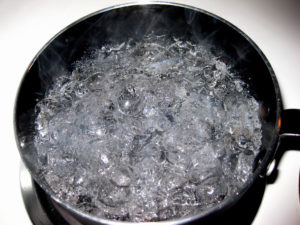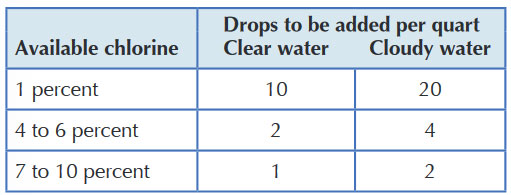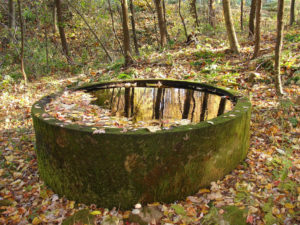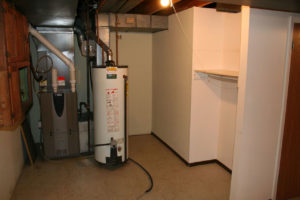After a disaster such as a hurricane or flood, your water supplies may have become contaminated or been temporarily cut off. To make sure your water is safe, follow these guidelines:
- Listen to and follow public announcements from your local authorities. They will tell you if your tap water is safe to drink or use for cooking and bathing.
- If the water is unsafe, use only bottled water, or boil or disinfect your water for cooking, cleaning or bathing.
- Until your water supply is tested and found to be safe, use only bottled, boiled or treated water for drinking, cooking, washing dishes, cleaning, brushing your teeth, washing your hands and bathing.
- If water is limited, use an alcohol-based hand sanitizer to wash your hands.
How to Disinfect Water

Boiling water is the best way to kill harmful organisms that can make you and your family sick.
Use clean containers (where possible) and follow these steps to creating safe drinking water:
- Strain the water through a clean cloth, coffee filter or paper towel into a container to remove any sediment or floating matter.
- Boil the water vigorously for at least 1 minute.
- After it cools, the water is ready to use. To improve the taste, you may add a pinch of salt to each quart of boiled water, or pour the water back and forth from one clean container to another several times.
Using Chemicals
If it is not possible to boil the water, strain it as in listed above, then disinfect it with bleach or iodine, whichever is available:

Liquid chlorine bleach (from the home laundry or grocery store).
Use common, unscented house hold laundry bleach. Read the product label to find percentage of chlorine and use this table to determine how much bleach to add to the water:
- Add bleach to the water and stir or shake the container thoroughly.
- Let the water stand for 30 minutes. If you can smell a slight chlorine odor, the water should be safe.
- If you cannot smell a slight chlorine odor, repeat the dosage and let the water stand for 15 more minutes before using it.
Tincture of iodine (from a medicine chest or first aid kit).
- For clear water, add 5 drops of iodine per quart of water. If the water is cloudy, add 10 drops of iodine per quart of water.
- Let the mixture stand for 30 minutes, after which water should be safe to use.
Private Water Supplies

If you have your own water supply, such as a well, cistern, spring or other private source, ask your health department or Texas AgriLife Extension office to inspect it for sanitary quality and to show you how to keep it safe.
You should also have your water tested for disease-causing bacteria such as E. coli or total or fecal coliforms. These and other bacteria can cause many diseases in people.
Under normal conditions if your water system is properly built and maintained, you can be confident that your water is safe to drink. However, under emergency or disaster conditions, particularly during floods, these sources may become dangerous to use. Unless you are assured otherwise by test results, you should presume that during a disaster, no water is safe, and disinfect all water during such emergencies.
Emergency Sources of Water
If water is hard to find, try:

Water sources in and around your home
- Water heaters: Turn off the power that heats the tank and let the tank cool. Place a container under the tank and open the drain valve at the bottom. Don’t turn the tank back on until utility services are restored.
- Toilet tank: The water in the tank (not the bowl) is safe to drink unless chemical treatments have been added.
- Water pipes: Release the air pressure into the plumbing system by turning on the faucet at the highest point in the house. Then drain the water from the lowest faucet.
- Outside: Rainwater and water from coiled garden hoses can be used after it is disinfected.
Other water sources
- If you must use an emergency water source, you can consider underground water, such as that obtained from wells or springs, or surface water, such as from a creek or lake. Underground water is less likely to contain contamination harmful to your health than is than water from surface sources.
- However, if underground water is unavailable, you may use surface water from a creek, river, lake or pond, in that order. If possible, obtain surface water upstream from inhabited areas and dip it from below the surface.
- Avoid water that has a dark color, emits an odor or contains floating materials; these characteristics may indicate that the water is polluted.
- Remember: When you are unsure of its quality, disinfect all water before consuming it.
Do not disinfect or drink water when it:
- Is dark in color
- Has an odor
- Contains floating material
- Contains chemicals from a spill such as oil or gas
Storing Water in Containers
Store disinfected water in clean, sanitary glass or plastic containers. Plastic containers are good because they are lightweight and unbreakable.
Don’t use metal containers because they may corrode and give the water an unpleasant taste.
How Much Water Do I Need to Drink Each Day?
Because water is so important to human survival, never ration it. Drink at least 2 quarts per day as long as supplies last.
Download or Print this Publication:
